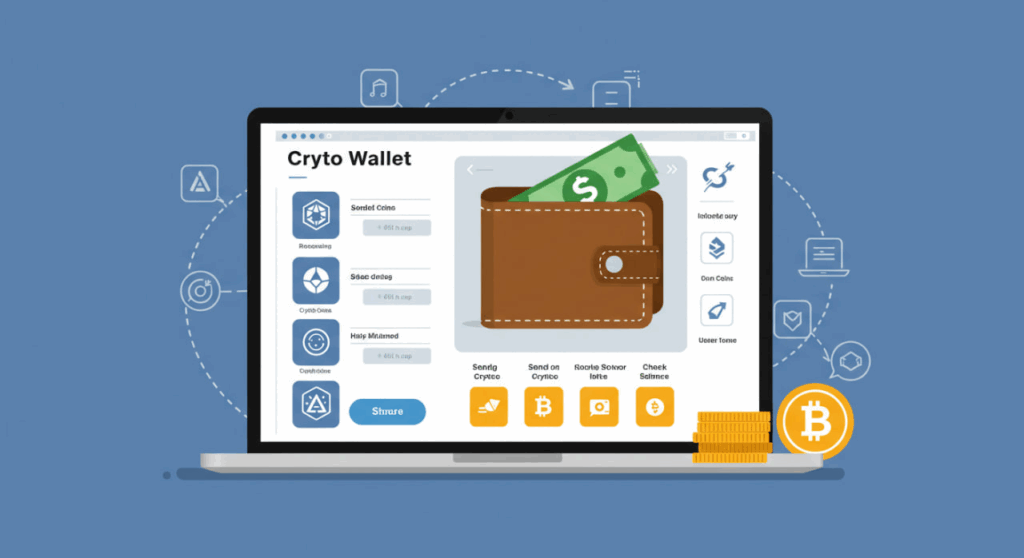Cryptocurrency is revolutionizing the way we think about money, and setting up a crypto wallet is your first step into this exciting digital world. A crypto wallet is like a secure online bank account for your digital currencies, such as Bitcoin or Ethereum. Don’t worry if you’re new to this—this guide will walk you through the process in a few simple steps. Let’s get started!
What Is a Crypto Wallet?
Before we begin, let’s clear up what a crypto wallet actually is. Unlike a physical wallet, it doesn’t store cash or cards. Instead, it holds the private keys (think of them as secret codes) that give you access to your cryptocurrencies on the blockchain—a decentralized digital ledger. There are different types of wallets, like software wallets (apps or websites) and hardware wallets (physical devices), but today, we’ll focus on setting up a basic software wallet for beginners.
Why Do You Need a Crypto Wallet?
A crypto wallet is essential if you want to buy, store, or send digital currencies. Without one, you can’t interact with cryptocurrencies directly. It’s your gateway to owning and managing your assets securely, whether you’re investing for the long term or just experimenting with small amounts.
Step-by-Step Guide to Setting Up a Crypto Wallet
Let’s break this down into actionable steps. For this guide, we’ll use a popular software wallet as an example, but the process is similar for most options out there.

Step 1: Choose a Reliable Wallet Provider
The first step is picking a trusted wallet provider. Look for one with a strong reputation, good user reviews, and robust security features. Some beginner-friendly options include web-based wallets or mobile apps that are easy to use. Research a few to see which fits your needs—consider factors like supported cryptocurrencies and user interface.
Step 2: Sign Up or Download the Wallet
Once you’ve chosen a provider, visit their official website or download their app from a trusted source (like the Apple App Store or Google Play). Avoid third-party links to prevent scams. Most wallets require you to create an account by providing an email address and setting a strong password. Make sure your password is unique and hard to guess—think of a mix of letters, numbers, and symbols.
Step 3: Secure Your Wallet with a Recovery Phrase
After signing up, the wallet will generate a recovery phrase (sometimes called a seed phrase). This is a string of random words—usually 12 or 24—that acts as a backup to access your wallet if you forget your password or lose your device. Write this phrase down on paper and store it somewhere safe, like a locked drawer. Never share it with anyone or store it digitally, as it’s the key to your funds!
Step 4: Add Funds to Your Wallet
Now that your wallet is set up, it’s time to add some cryptocurrency. You can do this by purchasing crypto through an exchange (a platform where you trade regular money for digital coins) and transferring it to your wallet’s address. Your wallet will display a unique string of characters called a public address—think of it as your “account number.” Copy this address and use it to receive funds from the exchange or another person.
Step 5: Keep Your Wallet Secure
Security is everything in the crypto world. Enable two-factor authentication (2FA) if your wallet offers it—this adds an extra layer of protection by requiring a second step, like a code sent to your phone, to log in. Also, avoid sharing your wallet details with anyone, and never click on suspicious links claiming to be from your wallet provider. Scammers are everywhere, so stay vigilant!
Bonus Tips for New Crypto Users
- Start Small: If you’re new, test the waters with a small amount of cryptocurrency while you learn the ropes.
- Explore Wallet Types: Once you’re comfortable, consider a hardware wallet for added security if you plan to store larger amounts.
- Stay Updated: The crypto space moves fast. Follow trusted news sources or communities to learn about updates and avoid scams.
Final Thoughts
Setting up a crypto wallet is easier than it seems, and it opens the door to a world of financial innovation. By choosing a reliable provider, securing your recovery phrase, and staying cautious, you’ll be ready to explore cryptocurrencies with confidence. Remember, this is just the beginning—take your time to learn and enjoy the journey into the digital economy!
Have questions or want to share your experience? Drop a comment below—I’d love to hear from you!




